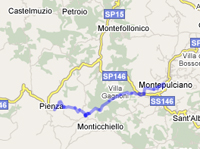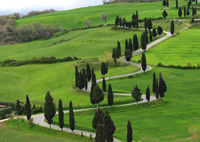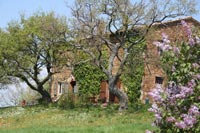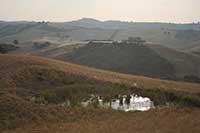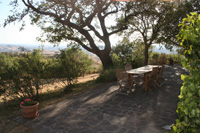 |
Pienza, Palazzo Piccolomini Garden overlooking the Val d'Orcia and Monte Amiata |
|
The small hanging garden that occupies the space on the south side of the building, is surrounded on three sides by high ivy-covered walls, while on the side facing the palace it is bordered by a loggia with three tiers of arches. A special drainage system prevents rainwater from seeping into the vaulted spaces below, in which the stables were located. The rectangular flower-beds, surrounded by double, pruned box hedges, line two gravel paths that run at right angles to each other. A fountain stands at the point where these meet, and the four corners of each flower-bed have umbrella-shaped laurel trees. The various rectangular flower-beds along the boundary walls are decorated with fruit trees and flowering shrubs. A large octagonal well adorned with the crescent, keys and tiara of the Piccolomini coat of arms, and a fountain decorated with garlands of fruit are the garden’s two sculptural elements; they both date back to the late 15th century. The panoramic view over Val d’Orcia, which can be admired from the three arches in the rear wall, is of primary importance in the design of this garden, a place in which architecture and nature come beautifully together. |
The Palazzo Piccolomini at Pienza, was built by Enea Silvio Piccolomini, who was Pope from 1458 to 1464, under the name of Pius II. In 1459, he constructed a palace for himself and his Cardinals and court in his small native town of Pienza. Like the Villa Medici, a major feature of the house was the commanding view to be had from the loggia over the valley, the Val d’Orcia, to the slopes of Monte Amiata. |
 |
The small hanging garden that occupies the space on the south side of the building, is surrounded on three sides by high stone walls covered in ivy, whilst the side overlooking the Palace is marked by a loggia and three tiered arcade. |
|
|||
Opening Hours |
||||
Opening Hours
OCTOBER 16 – MARCH 14 TUESDAY – SUNDAY: 10 am – 4:30 pm MARCH 15 – OCTOBER 15 TUESDAY – SUNDAY: 10 am – 6:30 pm December 25 / January 1, open 2 – 6 pm Palazzo closed |
||||
Enlarge map |
||||
|
||||
| Pienza, a small town near Siena, is a rare example of Renaissance town building. Defined, from time to time, the "ideal city", the "utopian city". It was in this Tuscan town that Renaissance town-planning concepts were first put into practice after Pope Pius II decided, in 1459, to transform the look of his birthplace. He chose the architect Bernardo Rossellino, who applied the principles of his mentor, Leon Battista Alberti. This new vision of urban space was realized in the superb square known as Piazza Pio II and the buildings around it: the Piccolomini Palace, the Borgia Palace and the cathedral with its pure Renaissance exterior and an interior in the late Gothic style of south German churches. Pienza is a beautiful Renaissance town in southern Tuscany's Orcia Valley. It was here that Tuscan town planning started when the town was designed in the 15th century to be the ideal Renaissance town. The center of town is the beautiful square, Piazza Pio II, with two Renaissance palaces and the Duomo with its classic Renaissance exterior. The Piazza Pio II is the main square of the town. It holds Pienza's major 15th century buildings: - Cathedral: built by Rossellino between 1459 and 1462. - Piccolomini Palace: home of the originally Siennese Piccolomini family, among which are the popes Pius II and Pius III, and the scholar & astronomer Alessandro Piccolomini. - Episcopal Palace. - Town Hall with a crenellated tower (1462). The square also features an ornate well designed by Rossellino. |
 Pienza, Pozzo dei Cani in the Piazzo Pio II, a well projected by Rossellino. |
|||
| Enea Silvio Piccolomini Pope Pius II 1405-1464
Enea was born in Corsignano on October 18, 1405 to Vittoria Forteguerri and Silvio Piccolomini. The secrets rooms The true architectural theme of Palazzo Piccolomini is its relationship with nature and the landscape. From the portico on the rear, unfolds an extraordinary view of the Valdorcia and Monte Amiata. Inserted into this panorama, on the ground floor of the palazzo, a square-shaped garden bound by walls with a well in the middle, is the first hanging garden of the Renaissance. |
||||
|
|
|||
 |
 |
 |
||
Pienza, Palazzo Piccolomini, garden |
Pienza, Palazzo Piccolomini, the garden facade
|
Pienza, Palazzo Piccolomini, courtyard | ||
 |
 |
|||
Pienza, Piazza Pio II
|
Pienza, Palazzo Piccolomini | Pienza, Palazzo Piccolomini | ||
The walk takes off at Piazza Dante Alighieri, through the Viale S. Caterina, direction Pieve di Corsignano. Directions and map |
||||
A gentle up & downhill walk from the magnificent town Montepulciano to the perfect place Pienza along the beautiful scenery of Toscany. The walk starts at the Piazza Grande, next to the Duomo. Directions and map |
||||
Monticchiello
|
Montalcino, forttress |
|||
Montalcino is located to the west of Pienza, close to the Crete Senesi in Val d'Orcia. The hill upon which Montalcino sits has been settled probably since Etruscan times. Its first mention in historical documents in 814 AD suggests there was a church here in the 9th century, most likely built by monks who were associated with the nearby Abbey of Sant'Antimo. The town takes its name from a variety of oak tree that once covered the terrain. The very high site of the town offers stunning views over the Asso, Ombrone and Arbia valleys of Tuscany, dotted with silvery olive orchards, vineyards, fields and villages. During the late Middle Ages it was an independent commune with considerable importance owing to its location on the old Via Francigena, the main road between France and Rome, but increasingly Montalcino came under the sway of the larger and more aggressive city of Siena. The first medieval walls were built in the 13th century. The fortress of Montalcino is one of the most visited sites in the town. The fortress was built at the highest point of the town in 1361, on a pentagonal plan designed by the Sienese architects Mino Foresi and Domenico di Feo. The walls include the tower of San Giovanni and an ancient basilica which now serves as a chapel. Down the narrow, short street that extends from the main gate of the fortress is the Chiesa di Sant'Agostino with its simple Romanesque façade, also built in the 13th century. The building adjacent to the church is a one-time convent, but it is now the home of the Musei Riuniti which is both a civic and diocesan museum. The museums hold various works, including a gorgeous wooden crucifix by an unknown artist of the Sienese school, two beautiful 15th century wooden sculptures and several other sculptures in terracotta which appear to be of the Della Robbia school. The collection also includes a St Peter and St Paul by Ambrogio Lorenzetti and a Virgin and Child by Simone Martini. The Duomo (cathedral), dedicated to San Salvatore, was originally built in the 14th Century, but it now has a neo-classical appearance thanks to extensive renovation work that was done in the early 19th century under the direction of Sienese architect Agostino Fantasici. The main piazza, the Piazza del Popolo, is downhill from the fortress and Duomo on the via Matteotti. The principal building on the piazza is the town hall, once the Palazzo dei Priori (built late 13th, early 14th century) but now the Palazzo Comunale. The palace is adorned with the coats of arms of the Podesta who once ruled the city. A very high medieval tower is incorporated into the palazzo. Close by is a Renaissance structure with six round arches, called La Loggia, which was started at the very end of the 14th century and finished in the early 15th, but which has undergone much restoration work over the subsequent centuries. Montalcino is divided, like most medieval Tuscan cities, into quarters called contrade. The thirteenth-century church of San Francesco in the Castlevecchio contrada has undergone several renovations. Some of the interior frescoes were done by Vincenzo Tamagni in the early sixteenth century. Montepulciano, is built along a narrow limestone ridge and, at 605 m (1950 ft) above sea level, between Val D'Orcia and Val di Chiana. The town is encircled by walls and fortifications designed by Antonio da Sangallo the Elder in 1511 for Cosimo I. Inside the walls the streets are crammed with Renaissance-style palazzi and churches most of which are located along the main street, called the Cordo that climbs up into the main square, Piazza Grande, which crowns the summit of the hill. The Corso is about 2 km long and offers a long procession of facades, almost an "exhibition" of high level architectural design. The name of Montepulciano derives from Latin Mons and Publicianus ("Mount of Publicianus"). According to legend, it was founded by the Etruscan King Porsenna of Chiusi. The main street of Montepulciano stretches for 1.5 kilometers from the Porta al Prato to the Piazza Grande at the top of the hill. The city is renowned for its walkable, car-free nature. The main landmarks include: The Palazzo Comunale, designed by Michelozzo in the tradition of the Palazzo della Signoria (Palazzo Vecchio) of Florence. Palazzo Tarugi, attributed to Antonio da Sangallo the Elder or Jacopo Barozzi da Vignola. It is entirely in travertine, with a portico which was once open to the public. The Cathedral of Santa Maria Assunta, or the Duomo of Montepulciano, constructed between 1594 and 1680, includes a masterpiece from the Sienese School, a massive Assumption of the Virgin triptych painted by Taddeo di Bartolo in 1401. The church of Santa Maria delle Grazie (late 16th century). It has a simple Mannerist façade with a three-arcade portico. The interior has a single nave, and houses a precious terracotta altar by Andrea della Robbia. The Sanctuary of the Madonna di San Biagio is on the road to Chianciano outside the city. It is a typical 16th century Tuscan edifice, designed by Antonio da Sangallo the Elder on a pre-existing Pieve, between 1518 and 1545. It has a circular (central) plan with a large dome over a terrace and a squared tambour. The exterior, with two bell towers, is built in white travertine. The walls of the city were designed and built under the direction of Grand Duke of Florence Cosimo I de' Medici in 1511 by Antonio da Sangallo the Elder. (Cosimo I was born in 1519 and only became Duke in 1537 so this is not possible) Also interesting to note while walking though the town is that Montepulciano is standing in for the Volturic Stronghold of Volterra in the film adaptation of the Stephenie Meyer novel New Moon, the second book in the popular Twilight Saga.
|
||||
Podere Santa Pia |
Podere Santa Pia, view from the garden on the valley below |
Podere Santa Pia, terrace | ||
 |
 |
 |
||
San Giovanni d'Asso |
The Castle of Gallico |
Monteroni d'Arbia |
||
The wide and enchanting landscape of the Val d'Orcia area became one of the Unesco World Heritage sites in March 2005. Here is the original justification reported in the Unesco web site: 'The Val d'Orcia is an exceptional reflection of the way landscape was re-designed in Renaissance times to reflect the ideals of good governance and to create aesthetically pleasing pictures. Painters from the Siennese School, which flourished during the Renaissance, celebrated landscape of the Val d'Orcia. Images of the Val d'Orcia, particularly depictions of landscapes in which people are shown living in harmony with nature, are now considered strongly representative of the Renaissance and have profoundly influenced the development of landscape thinking. |
||||
|
||||
| Podere Santa Pia offers magnificent panoramic views of the mystical Maremma hills up to the Mediterranean Sea and Montecristo (and here even Corsica). |
||||



